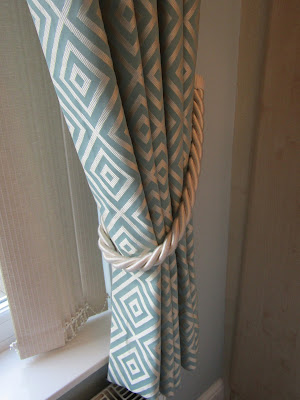
 Tartan wasn't quite tricky enough, so roll on the silk! Literally. The stuff won't stop moving. Any tips for keeping it still? Is spray starch any good for this?
Tartan wasn't quite tricky enough, so roll on the silk! Literally. The stuff won't stop moving. Any tips for keeping it still? Is spray starch any good for this? Before I hack the silk though I'm making a toile out of a polyester silky satin to check that the finished dress will fit. Thank you Auntie Moira for the lovely fabric! Do you like what I've done with it?
Before I hack the silk though I'm making a toile out of a polyester silky satin to check that the finished dress will fit. Thank you Auntie Moira for the lovely fabric! Do you like what I've done with it?The bodice
I started by tacking stay tape to the shoulder seams of the front and back pieces (centering the tape over the stitching line of the fabric) and ironing (after tacking) bias vilene tape to the armhole and neck edges of the front and back pieces (this time placing the stitching, which is on the tape, on the stitching line of the fabric).
The bodice is worked by attaching the front bodice to the front bodice lining and the same for the back bodice. Then you put one inside the other and join the shoulder seams of the dress together and then the same for the lining shoulder seams. Finish by pressing the shoulder seams open and turning it all right side out.
The skirt is very simple to make; simply sew the front and back pieces together at the side seams and then tack the lining to the skirt by putting it inside the skirt, wrong sides together.
The only difficulty I had is with the fabric stretching slightly as it is cut on the bias. I'm hoping my silk will be a bit more robust and I'll have to make sure I handle it a bit more carefully.
Attaching the two
Next was attaching the front pieces of the bodice and skirt. Again this was very simple and I sewed the seam allowance down (using top stitching) to create a channel which I fed my elastic through.
Finishing the back
The back pieces of the bodice and skirt do not get attached together as there is a nice opening there instead. I applied a facing to the opening which I turned through to the wrong side and secured. I then made two rouleau tubes and attached each one to either end of a piece of elastic which I threaded through the channel.
 Hemming the dress
Hemming the dress I used a rolled hem on my overlocker to finish both the dress and lining hems. This is the first time I've done a rolled hem and I really like the scalloped effect it creates on this fabric.
I used a rolled hem on my overlocker to finish both the dress and lining hems. This is the first time I've done a rolled hem and I really like the scalloped effect it creates on this fabric.And best of all the dress fits well so I can go ahead with making it in silk in time for the Summer.
Cost
| Item | Supplier | Quantity | £ |
| Floral silk satin | My auntie! | free | 0 |
| White silk satin lining | http://www.abakhan.co.uk/silky-satin-1-white-145cm.html | 2m @ £4.55 per metre | 9.1 |
| Thread | http://www.abakhan.co.uk/ | 2 @ £1.55 each | 3.1 |
| TOTAL | 12.2 |









































